Indexed in: ESCI, Scopus, PubMed,
PubMed Central, CAS, DOAJ, KCI
PubMed Central, CAS, DOAJ, KCI
FREE article processing charge

Previous issues
- Page Path
- HOME > Browse Articles > Previous issues
Original articles
- Cytotoxicity of dental self-curing resin for a temporary crown: an in vitro study
- Jae-wan Ko, Joon Sakong, Sohee Kang
- J Yeungnam Med Sci. 2023;40(Suppl):S1-S8. Published online April 26, 2023
- DOI: https://doi.org/10.12701/jyms.2023.00080
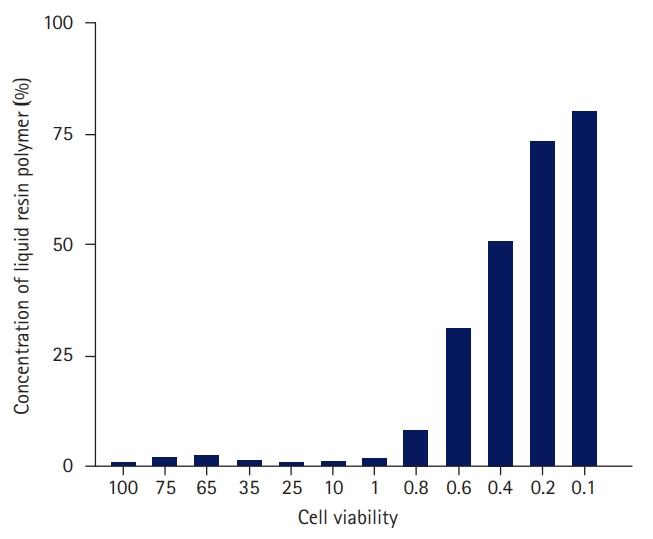
- 1,550 View
- 76 Download
-
 Abstract
Abstract
 PDF
PDF - Background
Residual monomer tests using high-performance liquid chromatography and cytotoxicity tests were performed to analyze the effect on the oral mucosa of a self-curing resin for provisional crown production.
Methods
A cytotoxicity test was performed to confirm whether leaked residual monomers directly affected oral mucosal cells. The cytotoxicity of the liquid and solid resin polymers was measured using a water-soluble tetrazolium (WST) test and microplate reader.
Results
In the WST assay using a microplate reader, 73.4% of the cells survived at a concentration of 0.2% liquid resin polymer. The cytotoxicity of the liquid resin polymer was low at ≤0.2%. For the solid resins, when 100% of the eluate was used from each specimen, the average cell viability was 91.3% for the solid resin polymer and 100% for the hand-mixed self-curing resin, which is higher than the cell viability standard of 70%. The cytotoxicity of the solid resin polymer was low.
Conclusion
Because the polymerization process of the self-curing resin may have harmful effects on the oral mucosa during the second and third stages, the solid resin should be manufactured indirectly using a dental model.
- Analysis of single nucleotide polymorphisms associated with the vitamin D pathway in the placentas of women with gestational diabetes mellitus: a laboratory study
- Mi Ju Kim, Hyun Mi Kim, Hyun-Hwa Cha, Won Joon Seong
- J Yeungnam Med Sci. 2023;40(Suppl):S9-S16. Published online May 8, 2023
- DOI: https://doi.org/10.12701/jyms.2023.00150

- 1,259 View
- 55 Download
-
 Abstract
Abstract
 PDF
PDF - Background
The aim of this study was to analyze the single nucleotide polymorphisms (SNPs) of genes known to be involved in vitamin D metabolism in the placenta using the placental tissue of mothers diagnosed with gestational diabetes mellitus (GDM) to determine whether the SNPs and occurrence of GDM are related.
Methods
We enrolled 80 women of the same gestational age, 40 with and 40 without GDM. The placenta was obtained from each woman after delivery and SNP genotyping was performed on seven SNPs in the CYP27B1 (rs10877012), CYP24A1 (rs2248359, rs6013897, and rs2209314), and GC (rs2282679, rs16847024, and rs3733359) genes. Maternal serum 25-hydroxyvitamin D levels were measured during the first trimester of pregnancy and before delivery.
Results
At the time of delivery, vitamin D levels were lower (21.05±12.05 mg/dL vs. 31.31±20.72 mg/dL, p=0.012) and the frequency of vitamin D deficiency was higher (60.7% vs. 32.5%, p=0.040) in the GDM group. In women with GDM, the G allele of rs10877012 was more common (86.3% vs. 65.0%, p=0.002). The rs10877012 GG genotype was more common in the GDM group (72.5% vs. 42.5%, p=0.007) and the rs10877012 TT genotype was more common in the control group (12.5% vs. 0%, p=0.007).
Conclusion
Mothers with GDM have lower serum concentrations of vitamin D before delivery than healthy controls and vitamin D deficiency is common. A polymorphism in CYP27B1 (rs10877012), is considered to be a cause of GDM pathogenesis.
- Evaluation of periodontal status in women with polycystic ovary syndrome versus healthy women: a cross-sectional study
- Sandhya Pavankumar, Pavan Kumar Yellarthi, Sandeep JN, Ramanarayana Boyapati, Trinath Kishore Damera, Naveen Vital Kumar G
- J Yeungnam Med Sci. 2023;40(Suppl):S17-S22. Published online May 8, 2023
- DOI: https://doi.org/10.12701/jyms.2023.00143

- 1,386 View
- 85 Download
-
 Abstract
Abstract
 PDF
PDF - Background
Polycystic ovary syndrome (PCOS) affects approximately 4% to 12% of females of reproductive age. Previous studies have shown an association between systemic and periodontal diseases. This study aimed to compare the prevalence of periodontal disease in women with PCOS and healthy women.
Methods
A total of 196 women aged 17 to 45 years were included in this study. Oral hygiene index-simplified (OHI-S), gingival index (GI), community periodontal index (CPI), and loss of attachment (LA) were assessed. Individuals who smoked, were pregnant, had any systemic disease (such as type 1 or type 2 diabetes mellitus, cardiovascular disease, malignancy, osteoporosis, and thyroid dysfunction), had a history of systemic antibiotic use in the past three months, or received any periodontal intervention in the past 6 months of screening were excluded. Student t-test was used to analyze the data. A p-value of <0.05 was considered statistically significant.
Results
Despite similar OHI-S scores (p=0.972) in the two groups, women with PCOS had significantly higher GI, CPI, and LA scores than healthy women (p<0.001).
Conclusion
Periodontal disease was more prevalent in women with PCOS than in healthy women. This finding may be due to the synergistic effects of PCOS and periodontitis on proinflammatory cytokines. PCOS may have an effect on periodontal disease, and vice versa. Hence, education on periodontal health and early detection and intervention for periodontal diseases is of paramount importance in patients with PCOS.
- Surgical results of only antegrade del Nido cardioplegia infusion in conventional coronary artery bypass grafting: a retrospective study
- Sang-Uk Park, Yo Han Bae, Yun Seok Kim, Kyungsub Song, Woo Sung Jang
- J Yeungnam Med Sci. 2023;40(Suppl):S23-S28. Published online June 28, 2023
- DOI: https://doi.org/10.12701/jyms.2023.00283
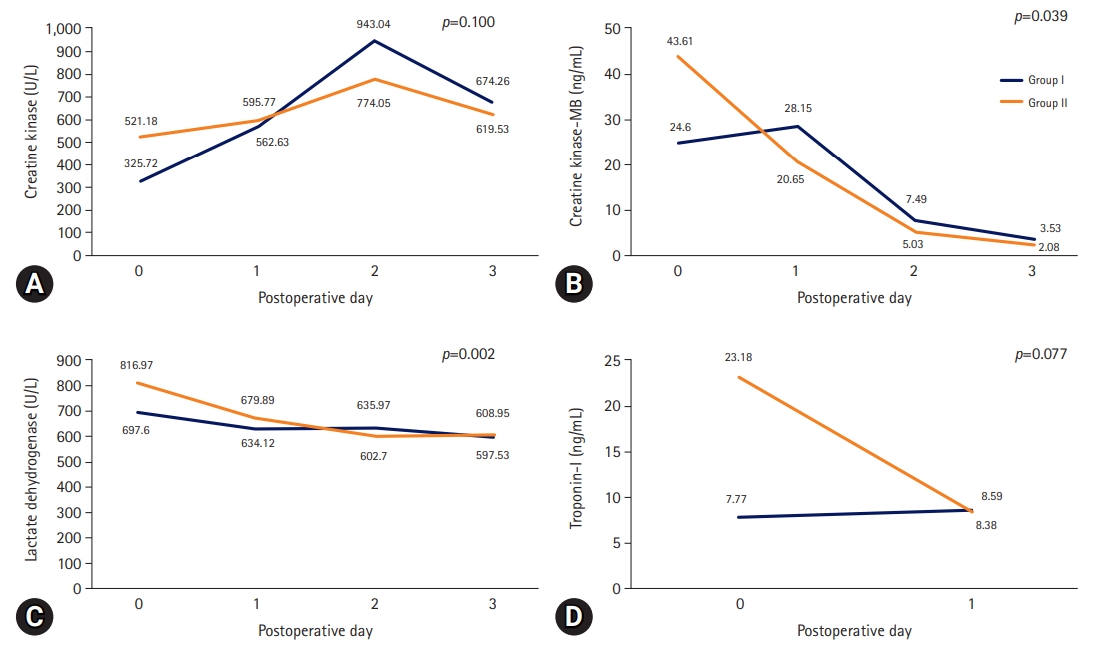
- 865 View
- 38 Download
-
 Abstract
Abstract
 PDF
PDF - Background
Additional retrograde cardioplegia infusion in conventional coronary artery bypass grafting (CABG) was introduced to address the concern of inappropriate cardioplegia delivery through the stenotic coronary artery. However, this method is complex and requires repeated infusions. Therefore, we investigated the surgical outcomes of only antegrade cardioplegia infusion in conventional CABG.
Methods
We included 224 patients who underwent isolated CABG between 2017 and 2019. The patients were divided into two groups according to the cardioplegia infusion method: antegrade cardioplegia infusion with del Nido solution (n=111, group I) and antegrade+retrograde cardioplegia infusion with blood cardioplegia solution (n=113, group II).
Results
The sinus recovery time after release of the aorta cross-clamp was shorter in group I (3.8±7.1 minutes, n=98) than in group II (5.8±4.1 minutes, n=73) (p=0.033). The total cardioplegia infusion volume was lower in group I (1,998.6±668.6 mL) than in group II (7,321.0±2,865.3 mL) (p<0.001). Creatine kinase-MB levels were significantly lower in group I than in group II (p=0.039). Newly developed regional wall motion abnormalities on follow-up echocardiography were detected in two patients (1.8%) in group I and five patients (4.4%) in group II (p=0.233). There was no significant difference in ejection fraction improvement between the two groups (3.3%±9.3% in group I and 3.3%±8.7% in group II, p=0.990).
Conclusion
The only antegrade cardioplegia infusion strategy in conventional CABG is safe and has no harmful effects.
- Classification of dental implant systems using cloud-based deep learning algorithm: an experimental study
- Hyun Jun Kong
- J Yeungnam Med Sci. 2023;40(Suppl):S29-S36. Published online July 26, 2023
- DOI: https://doi.org/10.12701/jyms.2023.00465

- 1,769 View
- 98 Download
- 1 Web of Science
- 3 Crossref
-
 Abstract
Abstract
 PDF
PDF - Background
This study aimed to evaluate the accuracy and clinical usability of implant system classification using automated machine learning on a Google Cloud platform.
Methods
Four dental implant systems were selected: Osstem TSIII, Osstem USII, Biomet 3i Os-seotite External, and Dentsply Sirona Xive. A total of 4,800 periapical radiographs (1,200 for each implant system) were collected and labeled based on electronic medical records. Regions of interest were manually cropped to 400×800 pixels, and all images were uploaded to Google Cloud storage. Approximately 80% of the images were used for training, 10% for validation, and 10% for testing. Google automated machine learning (AutoML) Vision automatically executed a neural architecture search technology to apply an appropriate algorithm to the uploaded data. A single-label image classification model was trained using AutoML. The performance of the mod-el was evaluated in terms of accuracy, precision, recall, specificity, and F1 score.
Results
The accuracy, precision, recall, specificity, and F1 score of the AutoML Vision model were 0.981, 0.963, 0.961, 0.985, and 0.962, respectively. Osstem TSIII had an accuracy of 100%. Osstem USII and 3i Osseotite External were most often confused in the confusion matrix.
Conclusion
Deep learning-based AutoML on a cloud platform showed high accuracy in the classification of dental implant systems as a fine-tuned convolutional neural network. Higher-quality images from various implant systems will be required to improve the performance and clinical usability of the model. -
Citations
Citations to this article as recorded by- Accuracy of Artificial Intelligence Models in Dental Implant Fixture Identification and Classification from Radiographs: A Systematic Review
Wael I. Ibraheem
Diagnostics.2024; 14(8): 806. CrossRef - A Comparative Analysis of Deep Learning-Based Approaches for Classifying Dental Implants Decision Support System
Mohammed A. H. Lubbad, Ikbal Leblebicioglu Kurtulus, Dervis Karaboga, Kerem Kilic, Alper Basturk, Bahriye Akay, Ozkan Ufuk Nalbantoglu, Ozden Melis Durmaz Yilmaz, Mustafa Ayata, Serkan Yilmaz, Ishak Pacal
Journal of Imaging Informatics in Medicine.2024;[Epub] CrossRef - Advancements in artificial intelligence algorithms for dental implant identification: A systematic review with meta-analysis
Ahmed Yaseen Alqutaibi, Radhwan S. Algabri, Dina Elawady, Wafaa Ibrahim Ibrahim
The Journal of Prosthetic Dentistry.2023;[Epub] CrossRef
- Accuracy of Artificial Intelligence Models in Dental Implant Fixture Identification and Classification from Radiographs: A Systematic Review
- Diagnostic performance of F-18 FDG PET or PET/CT for detection of recurrent gastric cancer: a systematic review and meta-analysis
- Chang In Choi, Jae Kyun Park, Tae Yong Jeon, Dae-Hwan Kim
- J Yeungnam Med Sci. 2023;40(Suppl):S37-S46. Published online August 17, 2023
- DOI: https://doi.org/10.12701/jyms.2023.00220

- 1,422 View
- 51 Download
-
 Abstract
Abstract
 PDF
PDF - Background
This systematic review and meta-analysis investigated the diagnostic performance of F-18 fluorodeoxyglucose (FDG) positron emission tomography (PET) or PET/computed tomography (PET/CT) for the detection of disease recurrence after curative resection of gastric cancer.
Methods
The PubMed and Embase databases, from the earliest available date of indexing through November 30, 2019, were searched for studies evaluating the diagnostic performance of F-18 FDG PET or PET/CT to detect recurrent disease after gastric cancer surgery.
Results
Across 17 studies (1,732 patients), the pooled sensitivity for F-18 FDG PET or PET/CT was 0.82 (95% confidence interval [CI], 0.74–0.88) with heterogeneity of I2=76.5 (p<0.001), and the specificity was 0.86 (95% CI, 0.78–0.91) with heterogeneity of I2=94.2 (p<0.001). Likelihood ratio (LR) tests gave an overall positive LR of 6.0 (95% CI, 3.6–9.7) and negative LR of 0.2 (95% CI, 0.14–0.31). The pooled diagnostic odds ratio was 29 (95% CI, 13–63). The summary receiver operating characteristic curve indicates that the area under the curve was 0.91 (95% CI, 0.88–0.93).
Conclusion
The current meta-analysis showed good sensitivity and specificity of F-18 FDG PET or PET/CT for detecting recurrent disease after curative resection of gastric cancer despite heterogeneity in ethnicity, recurrence rate, histology, and interpretation method.
- Association between total body muscle percentage and prevalence of non-alcoholic fatty liver disease in Korean adults findings from an 18-year follow-up: a prospective cohort study
- Byoung Chan Ahn, Chul Yong Park, Jung Hee Hong, Ki Ook Baek
- J Yeungnam Med Sci. 2023;40(Suppl):S47-S55. Published online August 29, 2023
- DOI: https://doi.org/10.12701/jyms.2023.00605
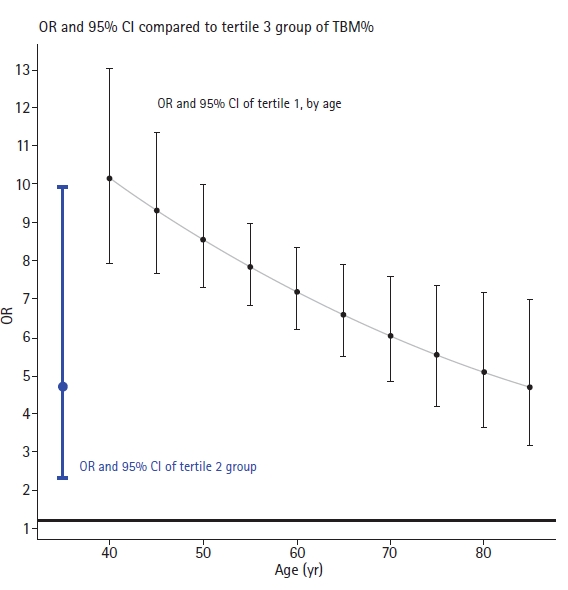
- 1,384 View
- 45 Download
-
 Abstract
Abstract
 PDF
PDF Supplementary Material
Supplementary Material - Background
This study aimed to elucidate the association between total lean muscle mass and the incidence of non-alcoholic fatty liver disease (NAFLD) in the adult Korean population.
Methods
Utilizing data derived from the 18-year prospective cohort of the Korean Genome and Epidemiology Study, NAFLD was diagnosed via the hepatic steatosis index with an established cutoff value of 36. Lean muscle mass was assessed via bioelectrical impedance analysis and subsequently divided into tertiles. A generalized mixed model with a logit link was employed for repeated measures data analysis, accounting for potential confounders.
Results
Analysis encompassed 7,794 participants yielding 49,177 measurements. The findings revealed a markedly increased incidence of NAFLD in the lower tertiles of muscle mass, specifically, tertile 1 (odds ratio [OR], 20.65; 95% confidence interval [CI], 9.66–44.11) and tertile 2 (OR, 4.57; 95% CI, 2.11–9.91), in comparison to tertile 3. Age-dependent decreases in the OR were observed within the tertile 1 group, with ORs of 10.12 at age of 40 years and 4.96 at age of 80 years. Moreover, each 1%-point increment in total muscle mass corresponded with an estimated OR of 0.87 (95% CI, 0.82–0.93) for NAFLD resolution.
Conclusions
The study demonstrates a significant association between total muscle mass and NAFLD prevalence among Korean adults. Given the potential endocrine role of muscle mass in NAFLD pathogenesis, interventions aimed at enhancing muscle mass might serve as an effective public health strategy for mitigating NAFLD prevalence.
- Incidence and risk factors of deep vein thrombosis and pulmonary thromboembolism after spinal cord disease at a rehabilitation unit: a retrospective study
- Yoonhee Kim, Minjae Jeong, Myung Woo Park, Hyun Iee Shin, Byung Chan Lee, Du Hwan Kim
- J Yeungnam Med Sci. 2023;40(Suppl):S56-S64. Published online September 20, 2023
- DOI: https://doi.org/10.12701/jyms.2023.00689
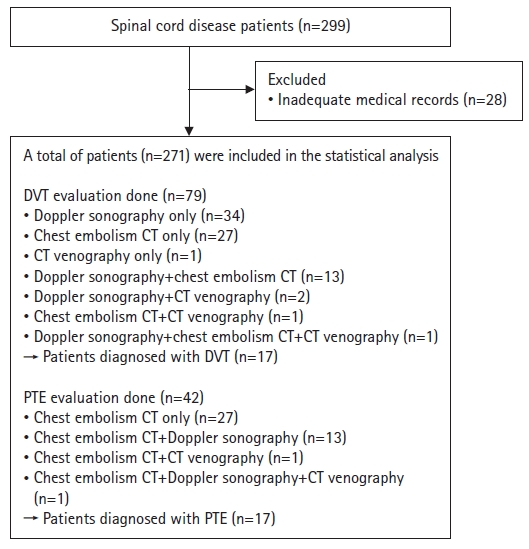
- 1,450 View
- 55 Download
- 1 Web of Science
- 1 Crossref
-
 Abstract
Abstract
 PDF
PDF - Background
Deep vein thrombosis (DVT) and pulmonary thromboembolism (PTE) are major complications of spinal cord disease. However, studies of their incidence in Korean patients are limited. Thus, this study investigated the incidence and risk factors of DVT and PTE in Korean patients with spinal cord disease.
Methods
We retrospectively analyzed the medical records of 271 patients with spinal cord disease who were admitted to a rehabilitation unit within 3 months of disease onset at a tertiary hospital. The presence of DVT and PTE was mainly determined using Doppler ultrasonography and chest embolism computed tomography. Risk factor analysis included variables such as sex, age, obesity, completeness of motor paralysis, neurological level of injury, cause of injury, lower extremity fracture, active cancer, and functional ambulation category (FAC) score.
Results
The incidences of DVT and PTE in the patients with spinal cord disease were both 6.3%. Risk factor analysis revealed that age of ≥65 years (p=0.031) and FAC score of ≤1 (p=0.023) were significantly associated with DVT development. Traumatic cause of injury (p=0.028) and DVT (p<0.001) were significant risk factors of PTE.
Conclusion
Patients with spinal cord disease developed DVT and PTE within 3 months of disease onset with incidence rates of 6.3% and 6.3%, respectively. Age of ≥65 years and an FAC of score ≤1 were risk factors for DVT. Traumatic cause of injury and DVT were risk factors for PTE. However, given the inconsistent results of previous studies, the risk factors for DVT and PTE remain inconclusive. Therefore, early screening for DVT and PTE should be performed in patients with acute-to-subacute spinal cord disease regardless of the presence or absence of these risk factors. -
Citations
Citations to this article as recorded by- Coagulation parameters correlate to venous thromboembolism occurrence during the perioperative period in patients with spinal fractures
Yong Jiao, Xiaohong Mu
Journal of Orthopaedic Surgery and Research.2023;[Epub] CrossRef
- Coagulation parameters correlate to venous thromboembolism occurrence during the perioperative period in patients with spinal fractures
- Comparison of serum anti-Müllerian hormone between unilateral and bilateral ovarian endometriomas during follicular, luteal, and random menstrual phases: a retrospective study
- Juhun Lee, Jong Mi Kim, Gun Oh Chong, Dae Gy Hong, Yoon Hee Lee
- J Yeungnam Med Sci. 2023;40(Suppl):S65-S72. Published online September 22, 2023
- DOI: https://doi.org/10.12701/jyms.2023.00661
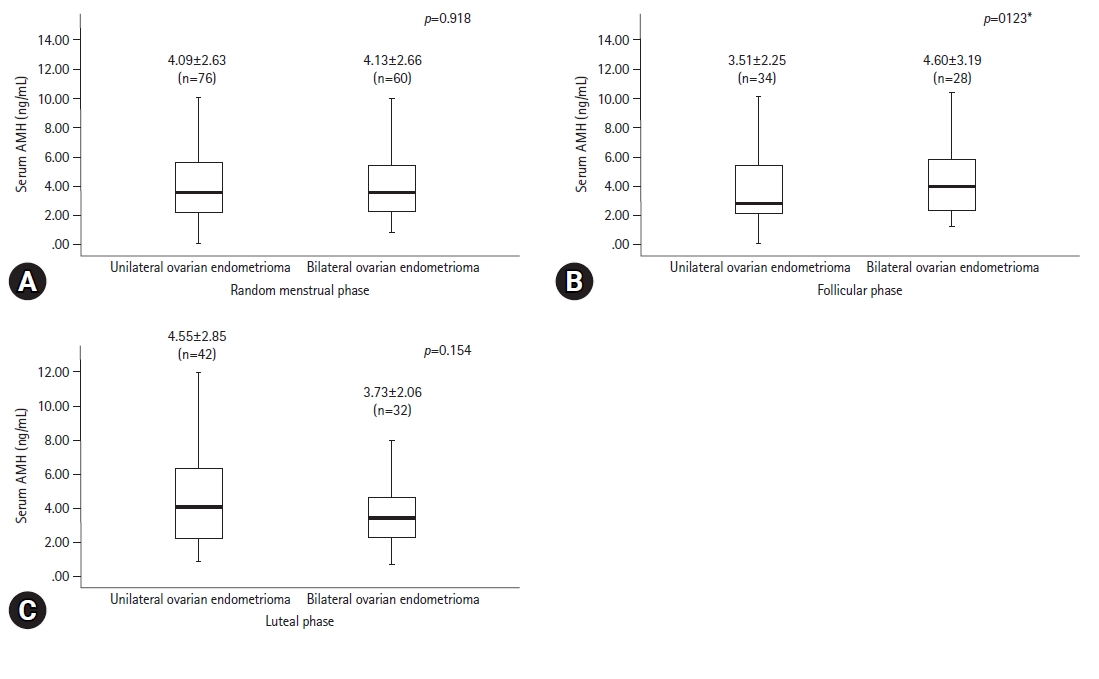
- 1,036 View
- 29 Download
- 1 Web of Science
- 1 Crossref
-
 Abstract
Abstract
 PDF
PDF - Background
Over the last two decades, serum levels of anti-Müllerian hormone (AMH) have been shown to be reliable markers of ovarian reserve. This study aimed to compare baseline serum AMH levels and well-controlled clinical factors between patients with unilateral and bilateral ovarian endometriomas during the menstrual phase.
Methods
We conducted a retrospective study. We enrolled 136 patients aged 18 to 36 years who were diagnosed with unilateral or bilateral ovarian endometriomas. Serum AMH levels of all patients and their latest two to three menstrual cycles were measured before surgery for ovarian endometriomas. The latest menstrual cycle length ranged from 26 to 30 days. Patients with irregular menstruation, a recent medication history of hormonal drugs other than oral contraceptive pills, a previous history of ovarian surgery, or any medical history influencing ovarian function were excluded.
Results
Of the 136 patients, 76 (55.9%) had unilateral ovarian endometriomas and 60 (44.1%) had bilateral ovarian endometriomas. Serum AMH levels were not significantly different between the two groups in the follicular phase, luteal phase, or at any random time point.
Conclusion
Serum AMH levels were not significantly different between unilateral and bilateral ovarian endometriomas in the follicular and luteal phases, or at any random time during the menstrual cycle when various confounding factors were excluded. -
Citations
Citations to this article as recorded by- The Relationship Between Serum Anti-Müllerian Hormone and Basal Antral Follicle Count in Infertile Women Under 35 Years: An Assessment of Ovarian Reserve
Ummey Nazmin Islam, Anwara Begum, Fatema Rahman, Md. Ahsanul Haq, Santosh Kumar, Kona Chowdhury, Susmita Sinha, Mainul Haque, Rahnuma Ahmad
Cureus.2023;[Epub] CrossRef
- The Relationship Between Serum Anti-Müllerian Hormone and Basal Antral Follicle Count in Infertile Women Under 35 Years: An Assessment of Ovarian Reserve
- Performance evaluation of Barozen Lipid Plus for point-of-care testing of lipid profiles: a method comparison study
- Soojoung Yu, Hwa Yeon Sun, Byungwook Yoo
- J Yeungnam Med Sci. 2023;40(Suppl):S73-S80. Published online October 20, 2023
- DOI: https://doi.org/10.12701/jyms.2023.00528
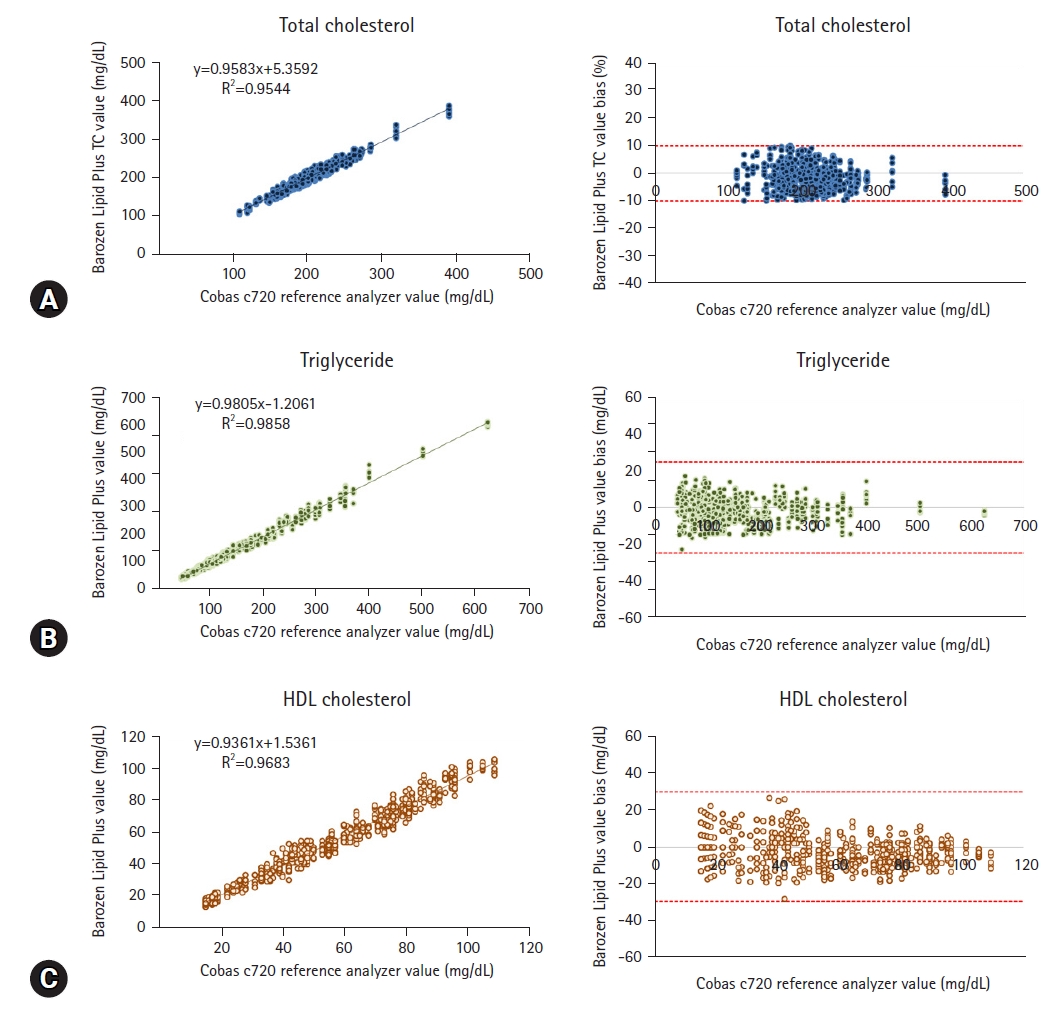
- 780 View
- 29 Download
-
 Abstract
Abstract
 PDF
PDF Supplementary Material
Supplementary Material - Background
The quick and easy nature of point-of-care (POC) testing devices allows regular monitoring of serum lipid levels to increase efficiency. The purpose of this study was to assess a POC lipid analyzer, Barozen Lipid Plus (MICO Biomed Co., Ltd.), which uses capillary blood to measure total cholesterol (TC), triglycerides (TGs), and high-density lipoprotein cholesterol (HDL-C).
Methods
Capillary and venous blood samples were collected from 110 participants at a single center in Korea between June 10 and June 26, 2021. TC, TG, and HDL-C measurements using Barozen Lipid Plus were compared with measurements using our reference device, the Roche-Hitachi Cobas 8000 c702 (Hitachi High-Technologies Corporation). This study followed the guidelines of the Clinical and Laboratory Standards Institute and the Clinical Laboratory Improvement Amendments. We surveyed participants regarding the convenience of the POC device using a questionnaire following the completion of blood collection.
Results
When compared to the reference equipment, the measurements obtained using Barozen Lipid Plus were more than 95% satisfactory within TC±10%, TG±25%, and HDL-C±30%. The coefficient of variation in the repeatability testing was within 5% for TC, 5% for TGs, and 7% for HDL-C. The survey results indicated high levels of satisfaction. No adverse events were reported.
Conclusion
These findings suggest that Barozen Lipid Plus is reliable for measuring lipid profiles and can therefore be used to monitor lipid levels at the time and place of patient care.
- Adult height in girls with central precocious puberty without gonadotropin-releasing hormone agonist treatment: a retrospective case-control study
- Hyun Ji Jang, Min Jung Kwak, Young Mi Kim, Soo-Han Choi, Kyung Hee Park, Hye Won Yoo, Su Jeong Park, Yoon Hee Jo, Ha Young Jo
- J Yeungnam Med Sci. 2023;40(Suppl):S81-S86. Published online November 7, 2023
- DOI: https://doi.org/10.12701/jyms.2023.00801
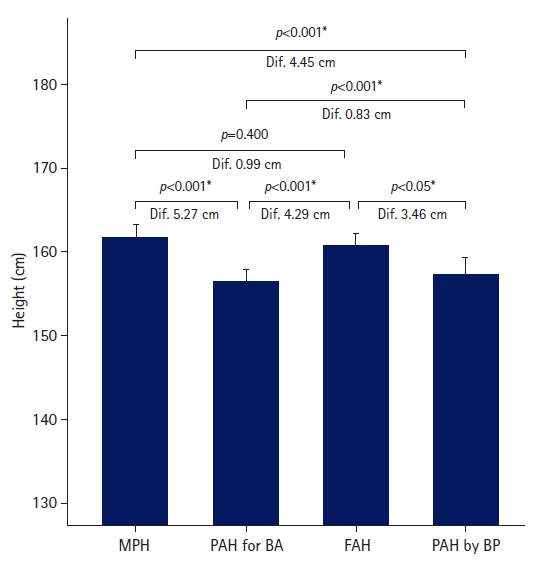
- 942 View
- 37 Download
-
 Abstract
Abstract
 PDF
PDF - Background
The primary aim of this study was to investigate the final adult height (FAH) of girls diagnosed with central precocious puberty (CPP) who were untreated.
Methods
We retrospectively analyzed the medical records of 36 girls diagnosed with CPP between 8 and 9 years of age who did not receive treatment, and 206 girls diagnosed with CPP within the same age range who received gonadotropin-releasing hormone (GnRH) agonist treatment. Midparental height (MPH), predicted adult height (PAH) obtained using height and bone age (BA) at the time of diagnosis (PAH for BA), and PAH obtained using the Bayley-Pinneau method (PAH by BP) were calculated. Additionally, height at the time of growth completion was compared with the predicted height.
Results
The FAHs were 160.71±4.56 cm in the untreated group and 159.31±4.26 cm in the treated group. In the untreated group, the FAH was 0.99±4.50 cm shorter than the MPH but 4.29±3.33 cm and 3.46±3.93 cm greater than the PAH for BA and PAH by BP, respectively.
Conclusion
In children diagnosed with CPP between 8 and 9 years of age who were untreated, FAH was greater than PAH for BA and PAH by BP at the time of diagnosis, indicating that the prognosis of FAH was not poor. Therefore, for girls diagnosed with CPP, it is recommended to consider various conditions, such as pubertal onset, height at diagnosis, BA, peak luteinizing hormone level, predicted height, and speed of puberty, when deciding whether to administer GnRH agonists.
Case reports
- Primary diffuse large B-cell lymphoma of the vulva: a case report
- Sun Yeon Kim, Ju Hwan Koo, Juhun Lee, Yu Jin Koo, Mi Jin Gu, Dae Hyung Lee
- J Yeungnam Med Sci. 2023;40(Suppl):S87-S92. Published online April 25, 2023
- DOI: https://doi.org/10.12701/jyms.2023.00108

- 1,159 View
- 62 Download
-
 Abstract
Abstract
 PDF
PDF - Diffuse large B-cell lymphoma (DLBCL) is a subtype of non-Hodgkin lymphoma (NHL) and is estimated to account for approximately 30% of all NHL cases. NHL can also occur in the female genital tract and accounts for approximately 1.5% of all NHL cases. Many doctors have difficulty diagnosing or treating vulvar DLBCL because of its very low prevalence. A 55-year-old woman presented with a solid mass on the right side of the vulva. No significantly enlarged lymph nodes were observed in the inguinal region. She underwent excisional biopsy at our institution. DLBCL was diagnosed based on histological examination. According to the Hans algorithm, the lesion was diagnosed as a non-germinal center B-cell-like subtype. The patient was referred to a hematologic oncologist. The disease stage was classified as IE according to the Ann Arbor staging classification. The patient received four cycles of chemotherapy with rituximab, cyclophosphamide, doxorubicin, vincristine, and prednisolone and localized radiation therapy with 36 Gy in 20 fractions. She showed complete remission and maintained this status on the latest computed tomography scan. Gynecologists should rule out lymphoma in patients presenting with a vulvar mass.
- Thyroid storm caused by metastatic papillary thyroid carcinoma tissue after total thyroidectomy: a case report
- So Hee Kwon, Min-Ji Kim, Sin Yeong Jung, Jae-Han Jeon
- J Yeungnam Med Sci. 2023;40(Suppl):S93-S97. Published online May 17, 2023
- DOI: https://doi.org/10.12701/jyms.2023.00199
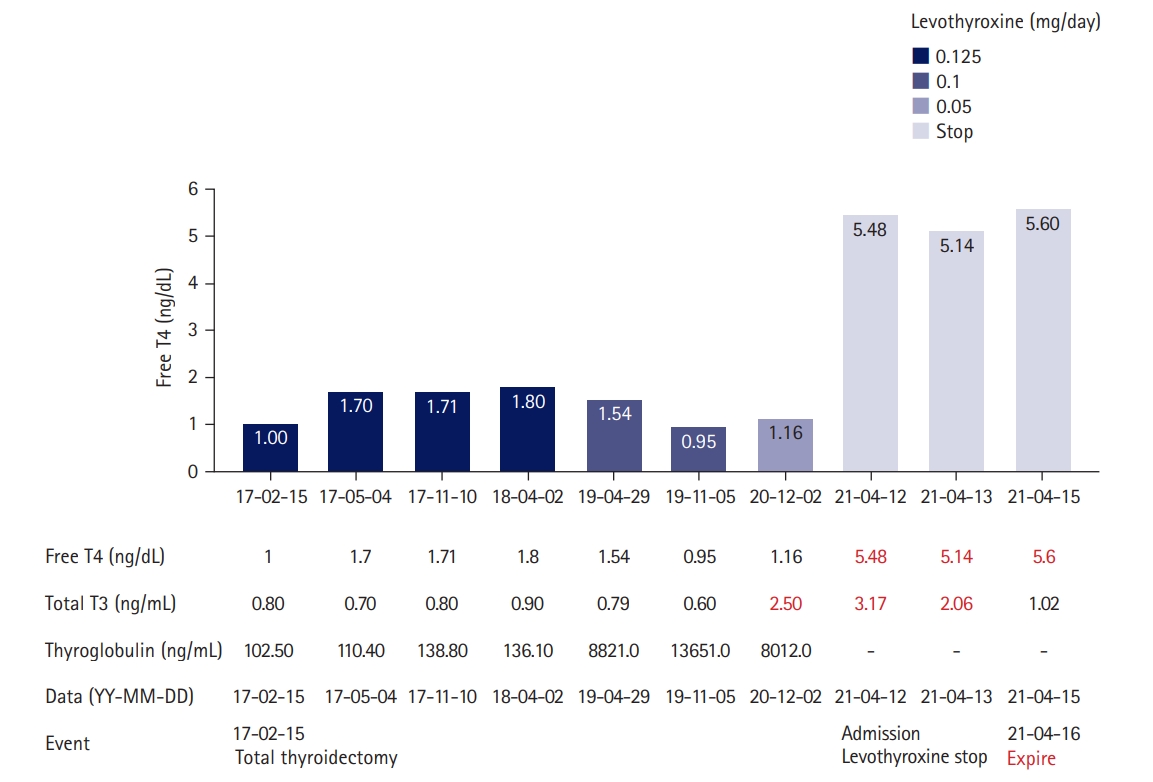
- 1,298 View
- 67 Download
- 1 Web of Science
- 1 Crossref
-
 Abstract
Abstract
 PDF
PDF - Thyroid storm is a life-threatening form of thyrotoxicosis and an endocrinological emergency. We present a case of thyroid storm in a patient with metastatic papillary thyroid cancer. A 67-year-old woman with a history of total thyroidectomy 4 years prior to presentation was admitted with deteriorating mental status, fever, and tachycardia. Laboratory tests revealed severe thyrotoxicosis. Although the patient had no residual thyroid tissue after total thyroidectomy, she had a previously diagnosed metastatic thyroid cancer lesion in the pelvic bone. Despite initial treatment with a standard thyroid storm regimen, the patient died 6 days after hospitalization. The patient had no history of Graves disease; however, a thyroxine receptor antibody was detected postmortem. The patient had a history of exposure to an iodine contrast agent, which is a rare cause of thyrotoxicosis. Thyroxine production from a differentiated thyroid carcinoma is rare but can be a source of clinically significant thyrotoxicosis in patients post-thyroidectomy. Overlapping Graves disease is a common stimulus; however, other causes, such as exogenous iodine, cannot be excluded. This case demonstrates that in the setting of metastatic thyroid carcinoma, thyrotoxicosis cannot be completely ruled out as a cause of suspicious symptoms, even in patients with a history of total thyroidectomy.
-
Citations
Citations to this article as recorded by- Data Analysis and Systematic Scoping Review on the Pathogenesis and Modalities of Treatment of Thyroid Storm Complicated with Myocardial Involvement and Shock
Eman Elmenyar, Sarah Aoun, Zain Al Saadi, Ahmed Barkumi, Basar Cander, Hassan Al-Thani, Ayman El-Menyar
Diagnostics.2023; 13(19): 3028. CrossRef
- Data Analysis and Systematic Scoping Review on the Pathogenesis and Modalities of Treatment of Thyroid Storm Complicated with Myocardial Involvement and Shock
- A rare pathogenic variant identified in a heart transplant recipient with hereditary transthyretin amyloidosis: a case report
- Myeong Seop Kim, Soo Youn Lee, Kyung-Hee Kim
- J Yeungnam Med Sci. 2023;40(Suppl):S98-S104. Published online May 30, 2023
- DOI: https://doi.org/10.12701/jyms.2023.00241

- 979 View
- 37 Download
-
 Abstract
Abstract
 PDF
PDF - Hereditary transthyretin (ATTRv) amyloidosis is a rare and complex genetic disorder that can lead to life-threatening cardiac amyloidosis and rapid disease progression. Early diagnosis and treatment with disease-modifying drugs can improve patient outcomes; however, heart transplantation may be necessary in some patients. We present the unique case of a 65-year-old Korean woman diagnosed with ATTRv amyloidosis after experiencing progressive neurological symptoms, followed by heart failure. Despite the absence of significant symptoms of heart failure, subsequent screening revealed cardiac amyloid infiltration, which caused left ventricular hypertrophy and rapid disease progression. The patient underwent successful heart transplantation, and subsequent genetic testing revealed a pathogenic variant, NM_000371.3:c.425T>C (p.Val142Ala), which affects both the nerves and heart and has not been previously reported in Korea. Our report underscores the potential benefits of heart transplantation in managing advanced ATTRv amyloidosis and emphasizes the need for continued research on the genetic heterogeneity of the disease. Clinicians should consider ATTRv amyloidosis in the differential diagnosis of patients presenting with neurological symptoms and heart failure, particularly in those with a family history of the disease.
- Unusual presentation of asymptomatic subacute lead-related ventricular perforation beyond the pericardium without pericardial effusion: a case report
- Jihee Son, Lae-Young Jung
- J Yeungnam Med Sci. 2023;40(Suppl):S105-S108. Published online May 31, 2023
- DOI: https://doi.org/10.12701/jyms.2023.00171

- 700 View
- 35 Download
-
 Abstract
Abstract
 PDF
PDF - The clinical manifestations of subacute pacemaker lead-related cardiac perforations are highly variable. Patients with subacute perforations can present with a variety of symptoms, whereas those with acute perforations usually present with cardiac tamponade that necessitates emergent pericardiocentesis. A 32-year-old woman underwent pacemaker implantation for sick sinus syndrome. An active-fixation atrial lead was fixed to the right atrial appendage, and a ventricular lead was fixed to the right ventricle (RV) apex, with acceptable parameters. Two weeks postoperative, the patient visited the clinic for routine examination of the pacemaker parameters. Chest X-ray showed migration of the RV lead beyond the cardiac silhouette. Echocardiography revealed no evidence of pericardial effusion or tamponade. Computed tomography revealed that the RV lead was positioned beyond the RV and pericardium and into the anterior chest wall. Procedural lead revision was performed with cardiothoracic surgery backup. The lead was retracted after loosening the active-fixation screw and inserting the stylet. The lead was placed in the RV septum with active fixation. The procedure was completed without complications, and the patient was discharged after 3 days. Subacute lead perforations can present with various symptoms, and some patients may be asymptomatic without pericardial effusion. Altered lead parameters frequently provide the first indication for the diagnosis of cardiac perforation. Transvenous lead revision with surgical backup is an alternative to surgical extraction.

 E-Submission
E-Submission Yeungnam University College of Medicine
Yeungnam University College of Medicine


 First
First Prev
Prev



